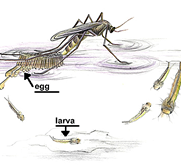Parameter Estimation of Two Mathematical Models for the Dynamics of Dengue and its Vector in Cali, Colombia
Main Article Content
Keywords
Aedes aegypti, dengue, mathematical models, population dynamics, parameter estimation
Abstract
Dengue is a viral infection transmitted by the female Aedes aegypti mosquito that lives in all tropical and subtropical regions of the planet. In Cali, Colombia, despite the controls that health officials say they are doing, this year, there have been more than 9,000 cases of dengue, of which some have been serious and others have become lethal. For the case of dengue virus transmission, mathematical models to simulate the dynamics of the infected population, either human or mosquito or both, allow a good understanding of the dynamics of the virus, so they are a good tool for monitoring and controlling the disease. However, for this tool to be really useful in a specific case, the models must be tailored to the particular characteristics of the region where you want to use them. In this paper, we present the fitting of two mathematical models to the urban area of Cali, Colombia. Initially, based on the natural behavior of the Aedes aegypti mosquito in a region as the area of interest, we estimate some of the parameters of the models, taking into account the existing literature on this topic. Subsequently, we estimate the others parameters as the (non-linear) least squares solution that best fits the output of the models to the data of reported cases of dengue, according to the Municipal Secretary of Cali, in 2010.
Downloads
References
S. de Salud Municipal de Cali, “Boletin epidemiológico semanal No. 48,” http://www.valledelcauca.gov.co/salud/descargar.phpid=17079, Diciembre 2015.
B. Alto and S. Juliano, “Temperature effects on the dynamics of Aedes albopictus (Diptera: Culicidae) populations in the laboratory,” Journal of Medical Entomology, vol. 38, pp. 548–556, 2001.
L. Rueda, K. Patel, R. Axtell, and S. R., “Temperature development and survival rates of Culex quinquefasciatus and Aedes aegypti (diptera : Culicidae),” Journal of Medical Entomology, vol. 27, pp. 892–898, 1990.
W. Tun-Lin, T. Burkot, and B. Kay, “Effects of temperature and larval diet on development rates and survival of the dengue vector Aedes aegypti in North Queensland, Australia,” Medical and Veterinary Entomology, vol. 14, no. 1, pp. 31–37, 2000.
H. Yang, M. Macoris, K. Galvani, M. Andrighetti, and D. Wanderley, “Assessing the effects of temperature on the population of Aedes aegypti, the vector of dengue,” Epidemiology & Infection, vol. 137, no. 8, pp. 1188–1202, 2009.
H. Yang, M. da Graça Macoris, K. Galvani, and M. Andrighetti, “Follow up estimation of Aedes aegypti entomological parameters and mathematical modellings,” BioSystems, vol. 103, no. 3, pp. 360–371, 2011.
J. Couret, E. Dotson, and M. Q. Benedict, “Temperature, larval diet, and density effects on development rate and survival of aedes aegypti (diptera: Culicidae),” PLoS One, vol. 9, no. 2, p. e87468, 2014.
C. Marín, A. Muñoz-Loaiza, H. Toro-Zapata, and L. Restrepo-Alape, “Modelado de estrategias para el control químico y biológico del Aedes aegypti,” Matemáticas: Enseñanza Universitaria, vol. 19, no. 1, pp. 63–78, 2011. [Online]. Available: http://www.redalyc.org/pdf/468/46818606006.pdf
R. Anderson and R. May, Infectious diseases of humans: dynamics and control. Oxford university press, 1992.
J. Arias, H. Martinez, L. Sepúlveda, and O. Vasilieva, “Predator-prey model for analysis of Aedes aegypti population dynamics in Cali,” International Journal of Pure and Applied Mathematics, vol. 105, no. 4, pp. 561–597, 2015.
L. Sepúlveda, O. Vasilieva, H. Martínez, and J. Arias, “Ross McDonald: Un modelo para la dinámica del dengue en Cali, Colombia,” Revista de Salud Pública, vol. 17, no. 5, pp. 749–761, 2015.
S. Towers, M. Khan, C. Castillo-Chavez, C. Romero-Vivas, and N. Walkers, “Untangling the underlying causes of seasonality of dengue and chikungunya epidemics in a tropical area: Barranquilla, CO,” Agosto 2015, Conferencia presentada en Second International and Interdisciplinary Worshop on Mathematical Modeling, Ecology, Evolution and Dynamics of Dengue and other Related Diseases, Villa de Leyva, Colombia.
“Base de datos disponible on-line.” [Online]. Available: http://institucional. ideam.gov.co/jsp/index.jsf
J. Suaya, D. Shepard, J. Siqueira, C. Martelli, L. Lum, L. Tan, S. Kongsin, S. Jiamton, F. Garrido, R. Montoya, B. Armien, R. Huy, L. Castillo, M. Caram, B. Sah, R. Sughayyar, K. Tyo, and S. Halstead, “Cost of dengue cases in eight countries in the Americas and Asia: a prospective study,” The American Journal of Tropical Medicine and Hygiene, vol. 80, no. 5, pp. 846–855, 2009.
K. Tomashek, T. Sharp, and H. Margolis, “Dengue,” CDCs Health Information for International Travel: 2014 (Yellow Book), 2014.
A. Costero, J. Edman, G. Clark, and T. Scott, “Life table study of Aedes aegypti (Diptera: Culicidae) in Puerto Rico fed only human blood versus blood plus sugar,” Journal of Medical Entomology, vol. 35, no. 5, pp. 809– 813, 1998.
F. Méndez, M. Barreto, J. Arias, G. Rengifo, J. Muñoz, M. Burbano, and B. Parra, “Human and mosquito infections by dengue viruses during and after epidemics in a dengue–endemic region of colombia,” The American Journal of Tropical Medicine and Hygiene, vol. 74, no. 4, pp. 678–683, 2006.
T. Scott, P. Amerasinghe, A. Morrison, L. Lorenz, G. Clark, D. Strickman, P. Kittayapong, and J. Edman, “Longitudinal studies of Aedes aegypti (Diptera: Culicidae) in Thailand and Puerto rico: blood feeding frequency,” Journal of Medical Entomology, vol. 37, no. 1, pp. 89–101, 2000.

